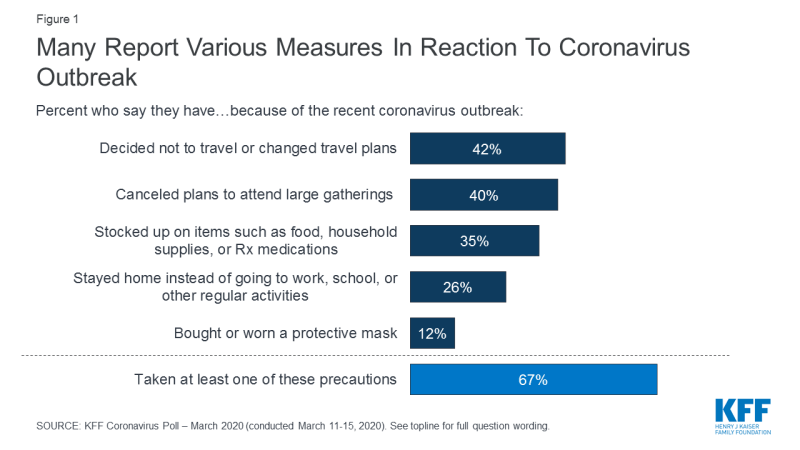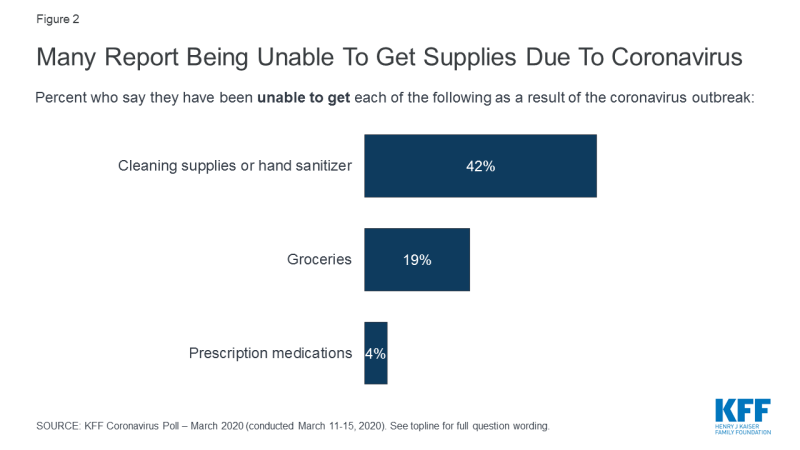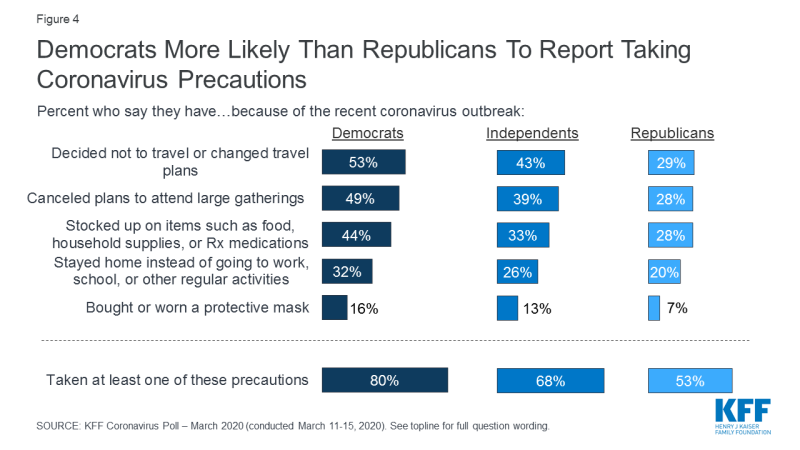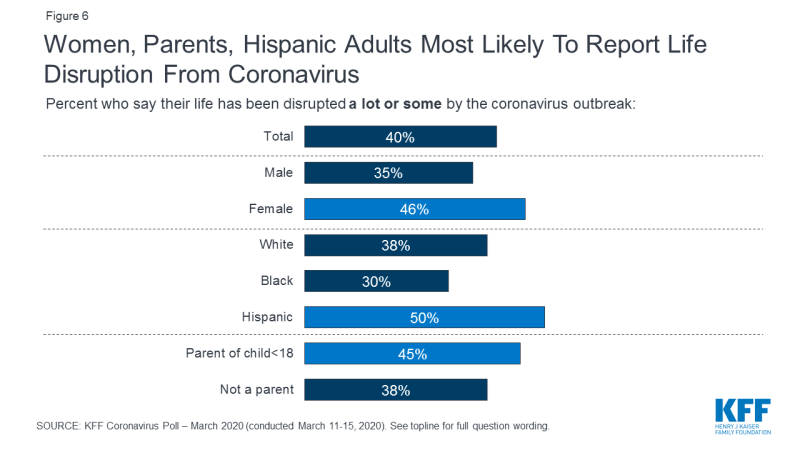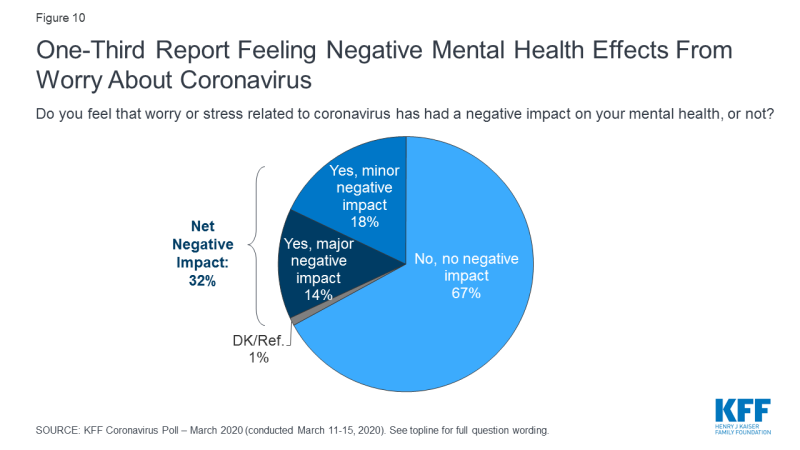KFF Coronavirus Poll: March 2020
In the midst of the largest health crisis to hit the United States and the world in the current era, a new KFF poll finds that many U.S. residents have faced disruptions in their lives from the coronavirus pandemic, and large shares are worried about their own risk as well as the economic consequences. This is an incredibly fast-moving crisis, with guidance and policy decisions changing daily. The new survey finds major differences from the KFF February Health Tracking Poll, and even in the span of the 5-day period in which the new survey was fielded, there were changes in the public’s levels of concern and reported behaviors. KFF will continue tracking the public’s attitudes and experiences in the coming weeks and months as the crisis evolves.
Key findings:
- Four in ten say their life has been disrupted “a lot” or “some” as a result of the coronavirus outbreak, and many worry that they or someone in their family will get sick (62%), that their retirement or college savings will be negatively impacted (51%), or that they won’t be able to afford testing or treatment for coronavirus if they need it (36%).
- Among workers, about half (53%) are worried they will lose income due to a workplace closure or reduced hours, and four in ten (41%) worry they will put themselves at risk of coronavirus exposure because they can’t afford to stay home from work. These worries are particularly prevalent among workers in lower-income households (earning less than $40,000 a year), part-time workers, and hourly wage-earners, many of whom say their employer does not offer them paid sick leave or paid time off to care for a sick family member.
- Parents of children under age 18 are disproportionately worried about someone in their family getting sick, and disproportionately likely to say their lives have been disrupted by the outbreak. Among parents facing school or daycare closures, two-thirds (66%) say their life has been disrupted. Lower-income parents and those who work non-salaried jobs are the most likely to say it would be difficult to find alternative childcare in the event of a school closure.
- The survey was in the field as social distancing measures were being put in place across the country, and many adults report taking measures like changing or canceling travel (42%), canceling plans to attend large gatherings (40%), stocking up on food, supplies and medications (35%), staying home instead of going to work or other regular activities (26%), and buying or wearing a protective mask (12%). Although older adults and those with serious health conditions are at greater risk from serious complications if infected with coronavirus, these groups are not more likely than the general public to report taking these types of precautions.
- Large shares of the public are aware of basic facts about the symptoms of coronavirus infection, as well as methods of transmission and recommended ways to slow the spread of the disease. While most also recognize that someone who thinks they are experiencing symptoms of coronavirus infection should stay and home and call a medical provider, one-quarter think they should seek care immediately at an emergency room or urgent care facility, rising to about four in ten (38%) among those with lower incomes.
- Large shares trust the U.S. Centers for Disease Control and Prevention and the World Health Organization to provide reliable information about coronavirus. About half (46%) trust President Trump, with sharp divides along partisan lines. Partisans are also divided on other attitudes and behaviors, with larger shares of Democrats than Republicans expressing worry, saying their lives have been disrupted, and to report taking various precautionary measures.
Precautions and Preparations
many report taking various measures to prepare FOR or protect against coronavirus, with few differences across age and health status but large partisan differences
About two-thirds of people report taking some type of precaution or making some type of preparation in reaction to the coronavirus outbreak. Most commonly, 42% say they decided not to travel or changed travel plans (up from 13% in the February KFF Health Tracking Poll), 40% say they canceled plans to attend large gatherings, and 35% say they stocked up on items like food, household supplies, or medications. One quarter (26%) say they stayed home instead of going to work, school, or other activities. Twelve percent say they bought or wore a protective mask, which is currently recommended only for those who are sick.
The survey was in the field over a period of five days (March 11-15), during which social distancing measures were being put into place across the country. Some of these precautions were more commonly reported among those who took the survey later in the field period. For example, among those who took the survey between March 13-15, 49% say they canceled plans to attend large gatherings, 47% say they changed travel plans, and 33% say they stayed home instead of going to work or regular activities.
Some people report being unable to get different types of supplies as a result of the outbreak, including about four in ten (42%) who say they were unable to get cleaning supplies or hand sanitizer, 19% who were unable to get groceries (rising to 30% among those who took the survey between March 13-15), and 4% who were unable to get prescription medications.
Older people and those who live in a household where someone has a serious health condition are not more likely than other groups to report taking various precautions, even though they are among the groups most at risk of developing serious complications if infected with coronavirus1.
Instead, there is a large partisan difference in the share who report taking precautions, with Democrats more likely than Republicans to say they changed travel plans (53% vs. 29%) or canceled plans to attend large gatherings (49% vs. 28%). Overall, eight in ten Democrats and about half of Republicans (53%) report taking at least one of these precautions.
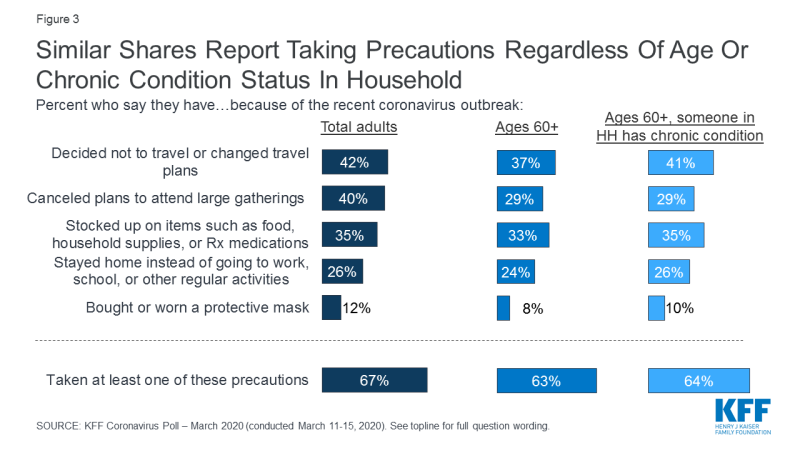
Figure 3: Similar Shares Report Taking Precautions Regardless Of Age Or Chronic Condition Status In Household
Despite widespread reports of the limited availability of testing for coronavirus, two-thirds of adults think they would be able to get a test if they needed one. Just over half of Democrats (53%) think they would be able to get a test if needed, compared to about two-thirds of independents (65%) and nearly three-fourths of Republicans (73%).
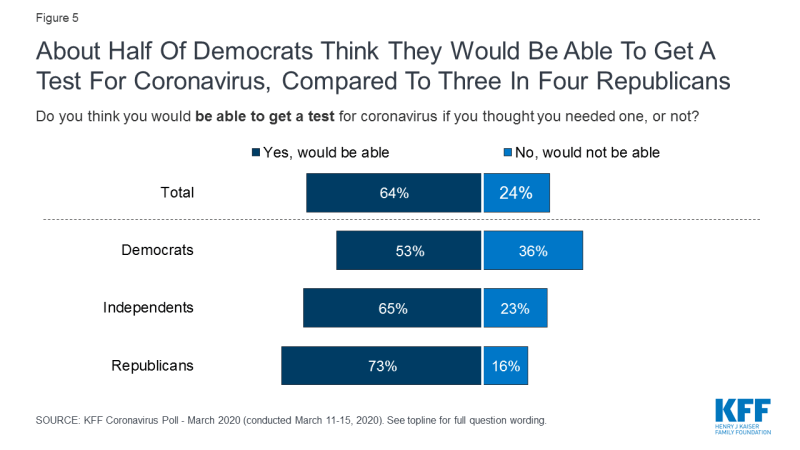
Figure 5: About Half Of Democrats Think They Would Be Able To Get Test For Coronavirus, Compared To Three In Four Republicans
Experiences and Worries
FOUR in ten say their life has been disrupted by the outbreak
Overall, 40% of the public says their life has been disrupted at least “some” by the coronavirus outbreak, including 16% who say it has been disrupted “a lot.” Among those answering the survey between March 13-15, half (50%) say their life was disrupted, including 22% who said it was disrupted “a lot.” Those most likely to say their life was disrupted include Hispanics (50%), women (46%), and parents of children under age 18 (45%).
There is also a partisan difference in the share reporting life disruption from the coronavirus, with about half of Democrats (49%) compared to three in ten Republicans (30%) saying their lives have been disrupted “a lot” or “some.”
| Table 1: Self-Reported Life Disruption from Coronavirus by Party Identification | ||||
| How much, if at all, has your life been disrupted by the coronavirus outbreak? | Party ID | |||
| Total | Democrats | Independents | Republicans | |
| A lot/Some (NET) | 40% | 49% | 40% | 30% |
| A lot | 16% | 18% | 17% | 14% |
| Some | 24% | 31% | 24% | 17% |
| Just a little/None (NET) | 59% | 51% | 60% | 70% |
| Just a little | 29% | 29% | 27% | 31% |
| None | 31% | 22% | 32% | 39% |
BIGGEST PERSONAL WORRY IS ABOUT A FAMILY MEMBER GETTING SICK, with large shares also worrying about lost income or savings
Large shares of the public report being worried about various potential impacts of coronavirus in their own lives. Most commonly, 62% say they are “very” or “somewhat” worried that they or a family member will get sick from coronavirus. About half also express financial worries, including that their investment savings will be negatively impacted (51%, rising to 61% among those with annual incomes over $90,000) or that they’ll lose income due to a workplace closure or reduced hours (46%). Just over a third (36%) worry they won’t be able to afford testing or treatment for coronavirus if they need it, including 64% of Hispanics and 66% of adults ages 18-64 without health insurance. A similar share (35%) of adults overall worry they will put themselves at risk of exposure to coronavirus because they can’t afford to stay home and miss work.
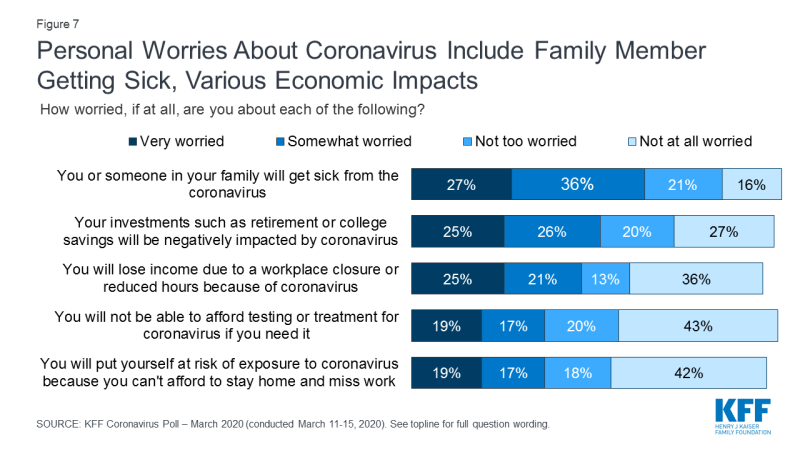
Figure 7: Personal Worries About Coronavirus Include Family Member Getting Sick, Various Economic Impacts
There are large partisan difference in worries about the coronavirus. Nearly three-quarters of Democrats (73%) say they are “very” or “somewhat” worried that they or someone in their family will get sick from the virus, compared with half of Republicans. Democrats are also much more likely than Republicans to worry about loss of job-related income (54% vs. 27%), being unable to afford coronavirus testing or treatment (46% vs. 16%), and putting themselves at risk of exposure because they can’t afford to miss work (43% vs. 20%).
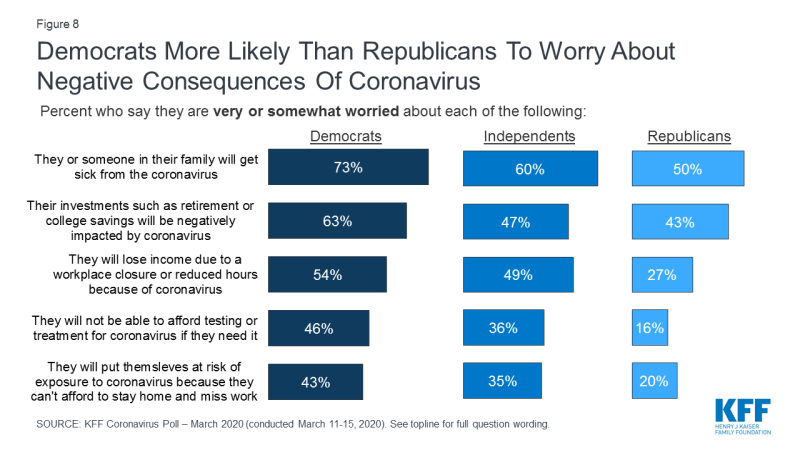
Figure 8: Democrats More Likely Than Republicans To Worry About Negative Consequences Of Coronavirus
Parents of children under age 18 (68%) are more likely than others to say they’re worried that someone in their family will get sick from coronavirus, as are Hispanics (83%) and those with incomes under $40,000 (68%).
Adults under age 60 are only slightly more likely than those ages 60 and older to worry about themselves or a family member getting sick (65% vs. 56%). Although those with serious health conditions are at higher risk for complications of coronavirus, those who have a chronic condition themselves of live in a household with someone who does are not significantly more likely to worry about themselves or a family member getting sick compared to those who say no one in their household has such a condition (65% vs. 61%).
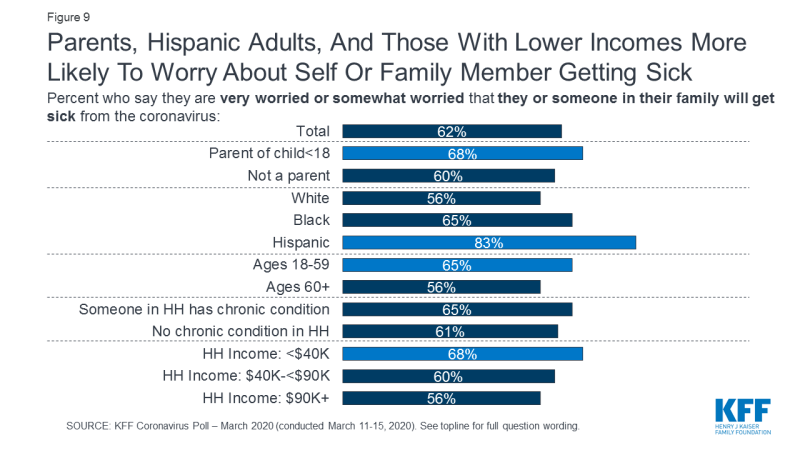
Figure 9: Parents, Hispanic Adults, And Those With Lower Incomes More Likely To Worry About Family Member Getting Sick
These worries are taking a toll for some. About a third of adults overall (32%) feel that worry and stress related to coronavirus has had a negative impact on their mental health, including 14% who say it has had a “major” impact.
LOW-INCOME, HOURLY, AND PART-TIME WORKERS ARE PARTICULARLY WORRIED, AND PARTICULARLY VULNERABLE TO ECONOMIC CONSEQUENCES
Work-related worries vary by people’s employment status. About half (53%) of those who are employed say they are very or somewhat worried that they will lose income due to a workplace closure or reduced hours because of coronavirus, rising to 73% of workers with household incomes less than $40,000, 68% of those who work part-time, 61% of those who are payed by the job, 60% of those who are paid by the hour, and 60% of those who are self-employed.
Four in ten workers (41%) express worry that they will put themselves at risk of exposure to coronavirus because they can’t afford to stay home and miss work, a worry that is highest among lower-income workers (60%), part-time workers (49%), and those paid by the hour (46%) or by the job (43%). Among those who say they or someone in their household works in a health care delivery setting, a group at higher risk for coronavirus exposure, 40% say they worry about putting themselves at risk because they can’t afford not to work.
| Table 2: Employment-Related Worries Related to Coronavirus | |||||||||||
| Percent who are very or somewhat worried that they will… | Hours | Compensation | Household income | Employer | |||||||
| Total employed | Full-time | Part-time | Salary | Hourly | By the job | <$40K | $40 to <$90K | $90K+ | Self-employed | Work for someone else | |
| Lose income due to a workplace closure or reduced hours because of coronavirus | 53% | 50% | 68% | 38% | 60% | 61% | 73% | 52% | 41% | 60% | 52% |
| Put themselves at risk of exposure to coronavirus because they can’t afford to and miss work | 41% | 39% | 49% | 30% | 46% | 43% | 60% | 38% | 28% | 37% | 42% |
One in ten employed adults report that they have already lost income from a job or business because of coronavirus. This share rises to about one-quarter (23%) among those who are self-employed, 21% of those who are paid by the job, and 18% of part-time workers.
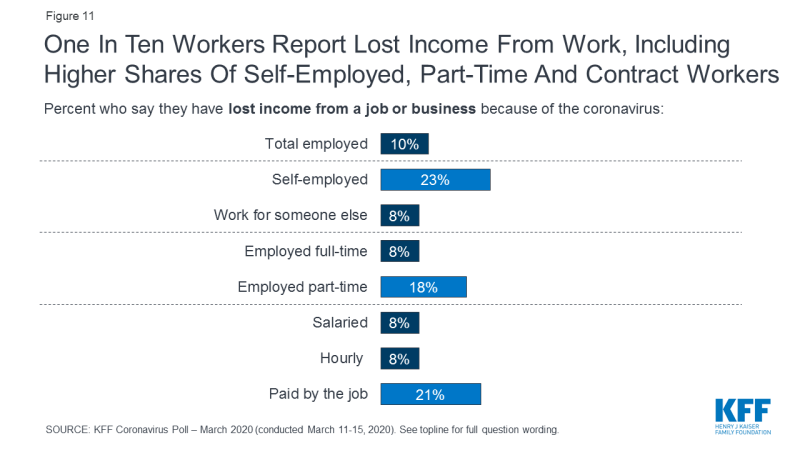
Figure 11: One In Ten Workers Report Lost Income From Work Or Business, Including One-Quarter Of Self-Employed And Contract Workers
As social distancing measures have been put in place across the country, many employers have asked or required all or part of their workforce to work from home. About half of those who are employed (45%) say they can do at least part of their job from home, but the share is much lower among lower-income workers (29%), part-time workers (32%), hourly workers (25%).
Most workers overall (64%) say their employer offers them paid time off if they are sick or ill, and about four in ten (43%) say their employer offers them paid time off to care for an ill family member. This leaves about one-third (32%) who say they do not get paid sick leave and about half (51%) who say they do not get paid family leave.
Those who work part-time, workers who are paid hourly or by the job, and those with lower incomes are much less likely to report having paid leave of any type. A recent KFF analysis provides more detail on how paid leave policies vary by state, average wage level, and employer size and discusses the implications for workers.
| Table 3: Remote Work and Paid Leave | |||||||||
| Among those who are employed | Total employed | Hours | Compensation | Household income | |||||
| Full-time | Part-time | Salary | Hourly | By the job | <$40K | $40 to <$90K | $90K+ | ||
| Percent who say if required to remain at home because of a quarantine or school or work closure, they could do at least part of their job from home | 45% | 48% | 32% | 79% | 25% | 47% | 29% | 42% | 63% |
| Percent whose employer offers them paid time off if they are sick or ill | 64% | 70% | 38% | 86% | 61% | 25% | 51% | 69% | 70% |
| Percent whose employer offers them paid time off to care for a family member who is sick or ill | 43% | 48% | 18% | 66% | 36% | 17% | 31% | 42% | 56% |
PARENTS FACING SCHOOL CLOSURES ARE PARTICULARLY LIKELY TO SAY THEIR LIVES HAVE BEEN DISRUPTED
Among parents of children under age 18, nearly half (45%) say their lives have been disrupted at least “some” by the coronavirus outbreak. Among those who say their child’s school or daycare has closed as a result of the outbreak, two-thirds (66%) say their lives have been disrupted, including 36% who say they’ve been disrupted “a lot.” About a third of parents (36%) in the survey overall say their child’s school or daycare has closed for some amount of time, a share that increased sharply throughout the survey field period. Among parents answering the survey between March 13-15, 63% say their child’s school or daycare had closed.
While most parents say it would not be difficult to find alternative childcare if their child’s school or daycare closed for 2 weeks or more, about one-third say it would be “very” or “somewhat” difficult. Those most likely to say it would be difficult include parents with household incomes less than $40,000 (46%), and working parents who do not get paid family leave (45%) or are paid by the hour or the job (42%).
| Table 4: Alternative Childcare Issues Among Parents | ||||||
| If your child’s school or daycare was closed for two weeks or more due to coronavirus, how difficult, if at all, would it be for you to find alternative childcare? | Total parents | Household income | Paid family leave? | Compensation | ||
| <$40K | $40K or more | Yes | No | Paid hourly or by job | ||
| Difficult (NET) | 33% | 46% | 27% | 27% | 45% | 42% |
| Very difficult | 19% | 29% | 13% | 11% | 28% | 24% |
| Somewhat difficult | 14% | 17% | 14% | 16% | 18% | 18% |
| Not difficult (NET) | 61% | 50% | 67% | 67% | 48% | 52% |
| Not too difficult | 15% | 13% | 14% | 19% | 12% | 12% |
| Not at all difficult | 47% | 36% | 53% | 48% | 36% | 40% |
| Not applicable/child doesn’t require childcare | 5% | 4% | 5% | 5% | 6% | 6% |
Knowledge and Sources of Information
Public mostly knows key facts about coronavirus, though some gaps in knowledge remain
Overall, large majorities of the public are aware of key information about prevention, transmission, risk, and treatment of coronavirus. However, sizeable shares hold some misconceptions that could potentially lead to confusion about how to identify symptoms or what to do if they or someone in their household becomes ill.
Overwhelming majorities, across partisans and demographic groups, know that frequent handwashing, staying home if you are sick, and avoiding large gatherings are recommended by public health experts as a way to help slow the spread of coronavirus. Nine in ten are aware that coronavirus can be transmitted by being in close proximity with someone who is infected and by touching surfaces that contain small amounts of bodily fluids from an infected person.
The public is also generally knowledge about the symptoms of coronavirus, as 95% know that a fever is a common symptom of the virus and 80% know that a dry cough is a common symptom. Overwhelming majorities know that adults ages 60 or older and those with pre-existing medical conditions are at a higher risk of developing serious medical complications from the coronavirus (96% and 98% respectively). About nine in ten (89%) are aware that there currently is no vaccine for coronavirus, and a similar share (86%) knows that the seasonal flu vaccine does not provide protection from the coronavirus.
However, there remain some notable knowledge gaps which may lead to confusion about when to seek care or testing or who is most at risk. For example, a majority of adults (56%) think nasal congestion is a common symptom of coronavirus. However, according to data reported by the World Health Organization, nasal congestion was present in only 5% of coronavirus cases in China.2 Similarly, four in ten adults mistakenly think children are at a higher risk of developing serious medical issues due the coronavirus, including 39% of parents. Thus far, however, children do not appear to be a higher risk.3
| Table 5: Public Knowledge About Various Aspects Of Coronavirus | |
| Large shares get many facts right… | But some knowledge gaps remain… |
| Recommendations to slow spread of coronavirus | |
| Between 88%-97% know that frequent handwashing, staying home if feeling sick, and avoiding large gatherings are recommended | 25% think it is recommended for health people to wear masks in public |
| How coronavirus is transmitted | |
| Nine in ten know transmission occurs through close physical proximity (90%) or touching surfaces that contain small amounts of bodily fluids from someone who is infected (91%) | 12% think coronavirus is transmitted through mosquito bites |
| Common symptoms | |
| Large majorities recognize fever (95%) and dry cough (80%) as common symptoms, and 85% know that rash is not a symptom | 56% think nasal congestion is a common symptom of coronavirus |
| Who is at most risk of serious complications | |
| Nearly everyone recognizes that people with chronic health conditions (98%) and those over the age of 60 (96%) have a higher risk of developing serious medical issues if they become infected | 40% think children are at higher risk |
| What happens to most people infected | |
| 65% recognize that most people infected with coronavirus recover without serious complications | 23% think most people develop serious complications that require intensive care. |
| Vaccine | |
| 89% know there is no vaccine for COVID-19, and 86% know that the flu vaccine doesn’t protect against it | |
While most adults (73%) know that someone who thinks they are experiencing symptoms of coronavirus should stay home and call a doctor or medical provider, one in four (25%) think that someone experiencing symptoms should seek immediate care at an emergency room or urgent care facility, including 38% of lower-income adults and 39% among those ages 18-64 who are uninsured.
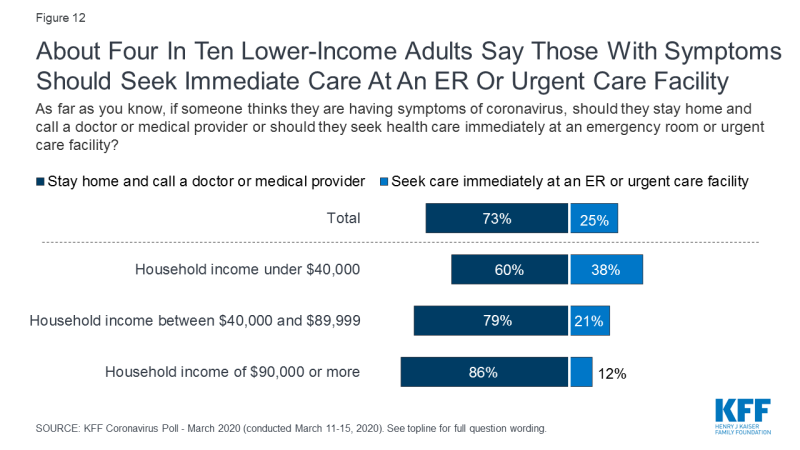
Figure 12: About Four In Ten Lower-Income Adults Say Those With Symptoms Should Seek Immediate Care At An ER Or Urgent Care Facility
most feel they have enough information TO PROTECT THEMSELVES, with cdc and who most trusted sources
About eight in ten adults (83%) say they feel they have enough information about how to protect themselves and their family from coronavirus while 16% say they don’t have enough information. The share who feel they don’t have enough information is somewhat higher among adults who are Black (25%) or Hispanic (22%), and those with a high school education or less (20%).
More than eight in ten adults (85%) say they trust the U.S. Center for Disease Control and Prevention (CDC) as a source for reliable information on coronavirus. More than three in four (77%) trust the World Health Organization (WHO) as a reliable source of information, while seven in ten trust their local government officials (70%) or their state government officials (71%). Fewer say they trust the news media (47%) and President Trump (46%) as a reliable source of information on coronavirus.

Figure 13: Most Trust The CDC And WHO As Sources Of Information While Half Trust The News Media And President Trump
There are some notable partisan differences on who the public trusts as reliable sources of information. While 88% of Republicans have a great deal or a fair amount of trust in President Trump to provide reliable information about coronavirus, 80% of Democrats say they have not much or no trust in the President. Notably, Democrats are more likely than Republicans to trust the news media to provide reliable information (69% vs. 29%).
Trust for both the CDC and WHO is high across partisan groups. Similar shares of Democrats (85%) and Republicans (90%) trust the CDC to provide reliable information about the virus, but Democrats are somewhat more likely than Republicans to trust the WHO (90% vs 71%).
| Table 6: Trust In Sources of Coronavirus Information By Party Identification | ||||
| Percent who say they trust each of the following a great deal or a fair amount to provide reliable information on coronavirus: | Total | Party ID | ||
| Democrats | Independents | Republicans | ||
| The U.S. Centers for Disease Control and Prevention, or CDC | 85% | 85% | 85% | 90% |
| The World Health Organization, or WHO | 77% | 90% | 75% | 71% |
| State government officials | 71% | 80% | 67% | 72% |
| Local government officials | 70% | 77% | 65% | 74% |
| The news media | 47% | 69% | 41% | 29% |
| President Trump | 46% | 19% | 42% | 88% |
More generally, when it comes in their level of trust in presidential candidates to handle public health emergencies like the coronavirus outbreak, about four in ten adults overall say they trust President Donald Trump (44%), Joe Biden (44%), and Bernie Sanders (41%) “a great deal” or “a fair amount.” There is a large partisan divide, with 86% of Republicans expressing at least a fair amount of trust in President Trump compared with 20% of Democrats. Among Democrats, at least seven in ten trust both Joe Biden (76%) and Bernie Sanders (70%) to handle a public health emergency.
| Table 7: Trust In Trump, Sanders, and Biden to Handle Public Health Emergencies | ||||
| How much do you trust each of the following to handle public health emergencies like the current coronavirus outbreak? | Total | Party ID | ||
| Democrats | Independents | Republicans | ||
| Donald Trump | ||||
| A great deal/a fair amount | 44% | 20% | 40% | 86% |
| Not much/Not at all | 51% | 79% | 53% | 11% |
| Bernie Sanders | ||||
| A great deal/a fair amount | 41% | 70% | 41% | 13% |
| Not much/Not at all | 48% | 23% | 47% | 80% |
| Joe Biden | ||||
| A great deal/a fair amount | 44% | 76% | 39% | 20% |
| Not much/Not at all | 45% | 18% | 49% | 74% |

